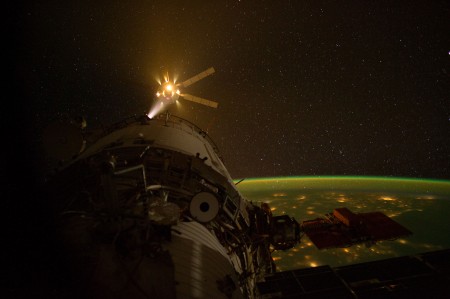SPACE PHOTO: Robot Ship Docking With The ISS. This Is Like Totally Sweet.
This picture right here is the glory to kick off your post-Easter week. Feeling woozy? Questioning the bloat in that belly of yours? Escape it all by shucking your mortal flesh and galavanting up to the stars courtesy of this picture. Robotic supply ships! Space! Party!
Hit the jump to find out what’s going on.
Bad Astronomy:
Wow. You can see the thrusters on the ATV burning to control its approach, like it’s right out of Star Trek! The stars, the green and brown aerosol layer over the Earth’s limb, the city lights slightly blurred from the ISS velocity of 8 km/sec — it gives such an eerie and unearthly feel to the picture!
As, I suppose, it should.
The ATV is amazing: this uncrewed machine can dock with the ISS using just GPS and star trackers – telescopes that can determine position and orientation by watching the stars… like ancient mariners did. [Update/correction: The ATV doesn’t dock with ISS using just GPS and star trackers; it makes its approach using those. Once it’s close enough, a more sophisticated laser guidance system is used.] This mission carried oxygen, water, hardware, spare parts, food, and even clothing for the astronauts.
While it’s docked, it may also be used as a booster, gently pushing the station into a new orbit to avoid space junk, or to boost the orbit higher. Although there’s almost no air up there, there’ssome. Over time, as the ISS plows through these rarefied molecules, it loses orbital energy and drops into a lower orbit. Periodic reboosts are necessary, and the ATV can be used for the job.
The ATV can stay docked for up to six months or so. After that, it undocks, de-orbits, and burns up in Earth’s atmosphere, making a spectacular fireball. A blaze of glory, you might say, for a machine that helps keep humans in space.
Goddamn awesome.




